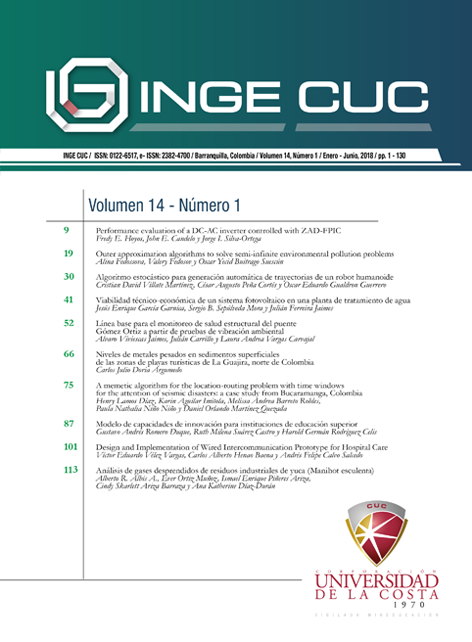Application of multivariate methods in the effectiveness of solvents in the pharmaceutical industry
DOI:
https://doi.org/10.17981/ingecuc.14.1.2018.12Keywords:
Multivariant analysis, solvents, principal components, classification, clusteringAbstract
Introduction: Solvents are chemical agents used in the pharmaceutical industry. Their importance is that their presence can accelerate or delay the reaction of a drug up to a million times.
Objective: The present investigation analyzes the different types of solvents in order to evaluate the existence of groups in which patterns related to the effectiveness of the mentioned solvents in medicine production can be identified.
Methodology: The study is comprised of 4 phases: 1) Principal component analysis; 2) Cluster analysis; 3) Discriminant analysis; 4) Interpretation of results and conclusions.
Results: Three clusters, categorized as supercritical, microspherical and biodegradable, were identified. The Hotelling T test yields a p-value of 0, evidencing the difference between groups. The quadratic discriminant yields a precision of a 96% for the classification of solvents.
Conclusions: The multivariate analysis allows modeling the effectiveness of solvents in the pharmaceutical industry. Hence, generating an objective decision methodology for the classification of solvents according to an effectiveness approach.
Downloads
References
[2] C. Capello, U. Fisher y K. Hungerbühler, «What is a green solvent? A comprehensive framework for the environmental assessment of solvents,» Green Chemistry, vol. 9, no. 9, pp. 927-934, 2007. http://dx.doi.org/10.1039/b617536h
[3] S. C. Shen, W. K. Ng, J. Hu, K. Letchmanan, J. Ng y R. B. H. Tan, «Solvent-free direct formulation of poorly-soluble drugs to amorphous solid dispersion via melt-absortion,» Advanced Powder Technology, vol. 28, no. 5, pp. 1316-1324, 2017. https://doi.org/10.1016/j.apt.2017.02.020
[4] O. S. Hammond, D. Bowron, A. J. Jackson, T. Arnold, A. Sanchez-Fernandez, N. Tsapatsaris y K. J. Edler, «Resilience of Malic Acid Natural Deep Eutetic Solvent Nanostructure to solidification and Hydration,» The Journal of Physical Chemistry B, vol. 121, no. 31, pp. 7473-7483, 2017. https://doi.org/10.1021/acs.jpcb.7b05454
[5] R. Minphimai, S. Piriyaprasarth y P. Sriamornsak, «Application of Artificial Neural Networks for Prediction of Ibuprofen Yield from Ultrasound-Assisted Anti-Solvent Crystallization,» Advanced Materials Research, vol. 1060, pp. 145-148, 2015. https://doi.org/10.4028/www.scientific.net/AMR.1060.145
[6] A. Parker, «Protic-dipolar aprotic solvent effects on rates of bimolecular reactions,» Chemical Reviews, vol. 69, no. 1, pp. 1-32, 1969. https://doi.org/10.1021/cr60257a001
[7] A. de Juan, G. Fonrodona y E. Casassas, «Solvent classification based on solvatochromic parameters: a comparison with the Snyder approach,» TraC trends in Analytical Chemistry, vol. 16, no. 1, pp. 52-62, 1997. https://doi.org/10.1016/S0165-9936(96)00079-9
[8] A. Katritzky, D. Fara , M. Kuanar, E. Hur y M. Karelson, «The classification of solvents by combining classical QSPR methodology with principal component analysis,» The Journal of Physical Chemistry A, vol. 109, no. 45, pp. 10323 - 10341, 2005. https://doi.org/10.1021/jp050395e
[9] L. Snyder, «Classification of the solvent properties of common liquids,» Journal of Chromatography A, vol. 92, no. 2, pp. 223-230, 1974. https://doi.org/10.1016/S0021-9673(00)85732-5
[10] N. Bondarev, «Exploratory analysis in thermodynamics of equilibria. Classification and prediction of benzoic acid strength in aqueous organic solvents,» Russian Journal of General Chemistry, vol. 86, no. 6, pp. 1221-1228, 2016. https://doi.org/10.1134/S1070363216060025
[11] K. Skalicka-Wozniack y I. Garrard, «A comprehensive classification of solvent systems used for natural product purifications in countercurrent and centrifugal partition chromatography,» Natural Product Reports, vol. 32, no. 11, pp. 1556-1561, 2015. https://doi.org/10.1039/C5NP00061K
[12] K. Dunn, « Solvents-OpenMV.net Datasets,» 14 Diciembre 2017. [En línea]. Available: www.http://openmv.net/info/solvents. [Último acceso: 14 Diciembre 2017].
[13] M. Aulton, La ciencia del diseño de las formas farmacéuticas, Leicester: Elsevier, 2004.
[14] S. F. Sneddon, D. J. Tobias y C. L. Brooks III, «Thermodynamics of amide hydrogen bond formation in polar and apolar solvents,» Journal of molecular biology, vol. 209, no. 4, pp. 817-820, 1989. https://doi.org/10.1016/0022-2836(89)90609-8
[15] C. Cuadras, Nuevos métodos de análisis multivariante, Barcelona: CMC Editions, 2014.
[16] H. Breu, J. GIL, D. Kirlpatrick y M. Werman, «Linear Time Euclidean distance transform algorithms,» IEEE Transactions on Pattern Analysis and Machine Intelligence, vol. 17, no. 5, pp. 529-533, 1995. https://doi.org/10.1109/34.391389
[17] S. Le, J. Josse y F. Husson, «FactoMiner: A package for Multivariate Analysis,» Journal of Statistical Software, vol. 25, no. 1, pp. 1-18, 2008. https://doi.org/10.18637/jss.v025.i01
[18] P. Trodler, R. D. Schmid y J. Pleiss, «Modeling of solventdependent conformational transitions in Burkholderia cepacia lipase,» BMC Structural Biology, vol. 9, no. 1, pp. 1-13, 2009. https://doi.org/10.1186/1472-6807-9-38.
[19] F. Kerton y R. MarriotT, Alternative Solvents for green chemistry, vol. 77, London: RSC Publishing, 2014. https://doi.org/10.1186/1472-6807-9-38.
[20] J. H. Ward Jr, «Hierarchical grouping to optimize an objective function,» Journal of the American Statistical Association, vol. 58, no. 301, pp. 236-244, 1963. https://doi.org/10.1080/01621459.1963.10500845
[21] U. Maulik y S. Bandyopadhyay, «Performance evaluation of some clustering algorithms and validity indices,» IEEE Transactions on Pattern Analysis and Machine Intelligence, vol. 24, no. 12, pp. 1650-1654, 2002. https://doi.org/10.1109/TPAMI.2002.1114856
[22] F. Tang, T. Hess, J. Valacich y J. Sweeney, «The effects of visualization and interactivity on calibration in financial decision-making,» Behavioral Research in Accounting, vol. 26, no. 1, pp. 25-28, 2013. https://doi.org/10.2308/bria-50589
[23] R. Swedberg, «Can You Visualize Theory? On the Use of Visual Thinking in Theory Pictures, Theorizing Diagrams, and Visual Sketches,» Sociological Theory, vol. 34, no. 3, pp. 250-275, 2016. https://doi.org/10.1177/0735275116664380
[24] B. P. Whim y P. G. Johnson, Directory of solvents, London: Springer Science & Business Media, 2012.
[25] B. Trèmillon, «Quemistry in non-aqueous solvents,» Reidel, p. 289, 1971.
Downloads
Published
How to Cite
Issue
Section
License
Copyright (c) 2018 INGE CUC

This work is licensed under a Creative Commons Attribution-NonCommercial-NoDerivatives 4.0 International License.
Published papers are the exclusive responsibility of their authors and do not necessary reflect the opinions of the editorial committee.
INGE CUC Journal respects the moral rights of its authors, whom must cede the editorial committee the patrimonial rights of the published material. In turn, the authors inform that the current work is unpublished and has not been previously published.
All articles are licensed under a Creative Commons Attribution-NonCommercial-NoDerivatives 4.0 International License.



 English
English
 Español (España)
Español (España)






















